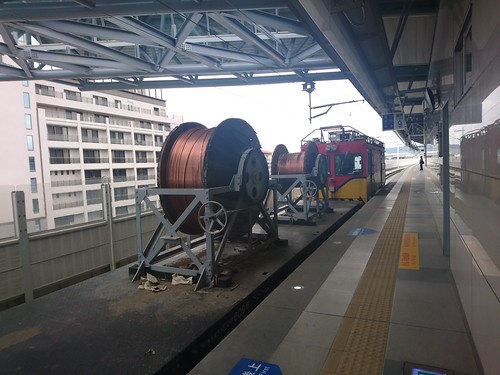Taiwan has the highest rate of precipitation of any developed country in the world, so why has it become known as a “water-starved island?” The answer, simply put, is sedimentation – silt now accounts for a third of the capacity at six of Taiwan’s 18 main reservoirs.The article then goes on to list all the causes of sedimentation. The article focused on Shihmen Dam:
We found more than 100 campgrounds built in the catchment area; indigenous peoples selling land to grow soil-scarring ginger; and 690 reports of activity over the past five years destroying the land, only to find that 90 percent were given the veneer of legality.The economic effect of this on Taiwan's industries has unusual results:
Wafer foundries, along with flat panel manufacturers, have been forced into long-term contracts to “nurture” fleets of water trucks. Under the arrangement, the water trucks operate freely but can be unconditionally mobilized at a moment’s notice when needed to combat a drought.Apparently Koreans have used this to claim that Taiwan's manufacturing sector is unstable. It's a solid article, with many interesting facts, but there's a word you won't find in it: price. As I noted years a while back in a column for Taiwan News:
Elsewhere the waste continues. The water price for industrial users in Taiwan is NT$11 per cubic meter, unchanged for two decades. In 2015, in response to prolonged drought, the government meekly decided to campaign to reduce water use from 270 liters a day per person all the way to 250, but this was a voluntary program, not mandatory.A major driver of Taiwan's water shortages is the absurdly low price of water, which no party wants to pay the political cost of raising. The reckoning will come, and it will fall on the DPP, which will likely still be governing in the early 2020s.
By comparison, in the UK and Germany water use is already around 2/3 of that figure. The low water prices not only encourage waste, but as the EPA pointed out two years ago when it called for higher water prices, low prices discourage industrial recycling of water, and impede the development of new water-related technology. They also keep the water authority starved for funds, meaning that urgent infrastructure upgrades arrive slowly, if at all.
The Greater Chaozhou Lake Project is fascinating...
Phase one of the Greater Chaozhou Artificial Lake Project has been allocated a budget of NT$1.4 billion. Over the past two years, trials have been run to replenish groundwater under the Pingtung Plain, and the manmade lake can be recharged with an estimated 150 million tons of underground water per year. After 10 years of replenishment, it is hoped that half of the water volume (75 million tons) can be extracted and used each year.There are several problems, among which is the complete lack of enforcement of regulations on illegal dumping. Companies routinely inject garbage, toxic waste, animal carcasses and other waste into the earth, or extract gravel and fill the area with refuse. The destruction is immense and hidden from the public eye. The government says that "Da Chaozhou Artificial Lake is not a lake, it's the largest Ground Water Recharge Project in Southeast Asia." (Video)
_______________________
[Taiwan] Don't miss the comments below! And check out my blog and its sidebars for events, links to previous posts and picture posts, and scores of links to other Taiwan blogs and forums!

1 comment:
>>The Greater Chaozhou Lake Project is fascinating...
Fascinating is also the "Zengwen (Tsengwen) Reservoir Sediment-Sluice Tunnel", with a smart way of dealing with sediment issue (using "Density Current Venting" method):
(1) Videos:
http://www.conf.tw/site/mypage.aspx?pid=162&lang=en&sid=1161
(2) Engineering Data and Pictures:
https://www.hydropower.org/case-studies/chinese-taipei-tsengwenzengwen
(3) Focus Taiwan news item:
http://focustaiwan.tw/news/aeco/201801280011.aspx
Another related project, "Desilting tunnel of Nanhua Reservoir," is also interesting:
(4) Renovation of Existing Reservoir in Taiwan for Sustainability (PDF file):
http://www2.hyd.ncku.edu.tw/iche2016/PDF/B.%20Reservoir%20Sediment%20Management/02-0028.pdf
Post a Comment